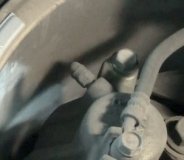Let me know how it goes after a few weeks. This is the first time I ran into this in such a short time frame. The first one I was involved with was a 1959 Edsel I bought at an auction. The previous owner put automatic transmission fluid in the master cylinder to swell the seals. That made the brakes work great, for a few days. After that, it took a full tank of gas to drive 55 miles to an old car show, and halfway back home. I coasted into a gas station parking lot and missed the pump by ten feet. I couldn't even push the car that far by hand due to the locked brake. Got home and once on the granite driveway, the right front tire skidded all the way to the house. That one only needed a master cylinder, four wheel cylinders, three rubber hoses, and flushing the lines.
Also ran into this on two customer cars, one done intentionally just before they sold it to my customer, and one supposedly done accidentally, "by someone else". The first one was an old Ford station wagon that ended up going to the junkyard. Second one was a newer car. The repair bill was quite high, but that car was worth saving.
Years later when I was teaching, I did a demonstration each year where I put rubber wheel cylinder lip seals into two beakers with fresh clean brake fluid. In one of them I put one drop of engine oil or power steering fluid, then we let them both sit for a week. After that week, the contaminated seal was mushy and had grown about 20 percent larger. In the master cylinder, those lip seals grow past the fluid return ports and blocks them. That keeps the brake fluid in the lines under pressure, and that keeps the brakes from releasing. As they heat up the brake fluid gets hot and expands, and that applies the brakes even harder. That's what happened to my Edsel.
The only way to solve that is to remove everything that has rubber parts that contact the brake fluid, flush and dry the steel lines, then install new rubber parts. If any rubber part is overlooked, the contamination will leach out of it and recontaminate the new fluid and parts. When the car has anti-lock brakes, the hydraulic controller must be replaced too because it has rubber o-ring seals. That can turn the repair into more than a $2,000.00 ordeal, and that is more than some cars are worth
Saturday, February 9th, 2019 AT 5:00 PM


